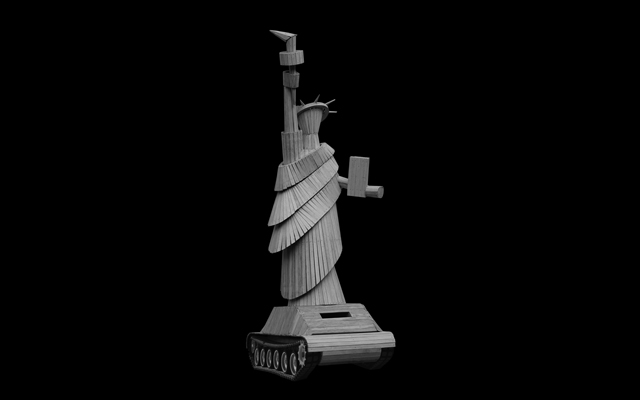
Curatorial Statement
Abandon all hope
The global imagination currently seems obsessed with our collective untimely demise. Haunting and confronting us at every turn – from Twitter to tabloids to endless breaking news cycles to feverish gossip – we regularly encounter hints of a world at its precipice. Genetically modified strains in everything we eat, viral videos of gun violence on people of color, a booming pharmaceutical industry, increasing wealth disparity acting as more the rule than the exception, drone strikes now standing in for assassination, terrorism as the new nightly news, and of course, perhaps the most paradigmatic social calamity of them all, climate change, all loom large in the collective freaked out imagination. Pedro Reyes’ labyrinthine artwork, Doomocracy, offers little in the way of relief but rather uses these apocalyptic scenarios to set his stage.
In thinking through the concept Reyes quipped, “Monsters are representations of our fears. Contemporary vampires are banks, zombies represent our fear of beggars, migrants, and the homeless; Frankenstein is a genetically modified organism, and by this logic, the Transpacific Trade Partnership is like an iron maiden of capitalism.” Out of this observation, Doomocracy, a house of political horrors, was born. Building on the vernacular American aesthetic of the haunted house, one that Reyes opined, “is certainly under-theorized”, this classic tradition of building fantastical frightful mazes to navigate during the witching season becomes the performative vehicle to reflect on a world whose one uniting belief is that the modernist dreams of progress have been all but abandoned. Doomocracy’s timing is clearly not accidental — transpiring within the daily echo of the United States elections as the psychological backdrop. One must surely admit a certain palpable cynicism this election season. With each party’s ticket seemingly driven more by the hate of their opponent than an urgent belief in their candidate. And in the end, a general public who anticipates that no candidate will truly address any of these concerns that weigh heavily on their mind.
Conjuring Dante’s Inferno, Doomocracy asks us to briefly “Abandon all hope, ye who enter here.” In this performative artwork– part Fox News, part Heironimous Bosch — the traditional horrors transform from creepy castles, vampires and zombies to corporate boardrooms, investors, and gun toting racists. Doomocracy acts as a mirror, perhaps a wacky fun house mirror, of the traumatic world outside. And in the spirit of Halloween, allows us to briefly confront, and even satirically enjoy, the demons that we, as people of this planet, live with daily.
In the wake of the Soviet Union’s late twentieth century undoing, writer Francis Fukuyama famously penned that the world had reached, “The end of history”. That is to say, that capitalism had become the final plan, and the historic movement of competing ideas around how the world should be governed had come to a close. Perhaps, given the current state of global affairs, there was more than a little truth to his statement.
Doomocracy takes place, poetically enough, at the Brooklyn Army Terminal. Born out of the First World War, the War to End all Wars, BAT was completed in 1919, imbued with the dreams and military sensibilities that would come to define America throughout the 20th century. Looking across the water from the site, one can see the Statue of Liberty acting as yet another symbol to the values that America not only embraces at home, but also, historically exports abroad.
In the history of art, of course, the First World War also gave birth to an important avant-garde movement built on rejecting the hopefulness that came with the Great War itself. It’s name was Dada. A childish absurd name, Dada rejected everything sensible and embraced the irrational. Founded in a nightclub in Zurich in 1916 (happy 100th birthday Dada!), Dada not only gave birth to a poetic rejection of rationality, but also to a certain disillusionment of the modern project that reverberates still as the spirit of our age (though too often minus the artfulness).
For Reyes, this work is both a dramatic departure and simultaneous logical next step in his expansive artistic oeuvre. Many, but not all, of Reyes’ artworks are participatory – most recently with Sanatorium (2011), Reyes built an interactive performance project where the audience becomes voluntary patients in an experimental therapy center. And due to his prolific output over the last twenty years, he has produced work that touches on a myriad of social and political topics ranging from gun violence (such as guns transformed into musical instruments in Disarm (2013)) to climate change (producing an environmentally friendly insect burger called the Grasswhopper (2013) as a solution to the carbon emissions produced by the meat industry).
More than most of his work, however, Doomocracy is culled from the tradition of satire or even the tradition of Dada itself. The artwork is comical with a form of humor that hurts. The sheer madness of the rooms so true one can only laugh. More rejection than solution, this work lives with one foot firmly planted in the canon of punk rock refusal. Working with a large cast and alongside theater director Meghan Finn, Reyes has brought into the world a participatory dream, part theater, part visual art, part Fluxus, part Dada and entirely, haunting. With Doomocracy, Reyes conjures a social space in which we can playfully confront our collective nightmares. Perhaps the most frightening element for Reyes is not what happens while one is inside the haunted house, but the realization as one exits, that the haunted house will continue once we leave.
– Nato Thompson, Artistic Director
(Doomocracy‘s Lady Liberty is an artwork inspired by Quino)
